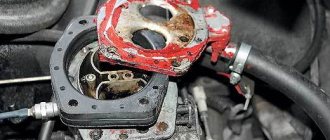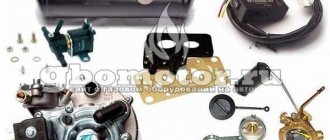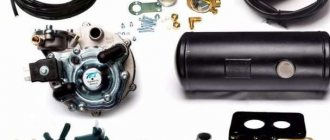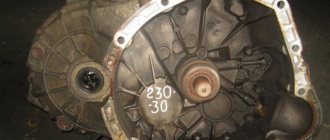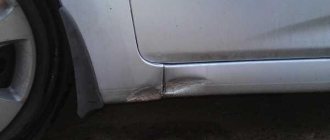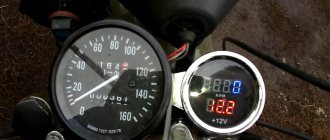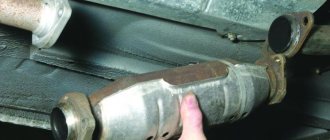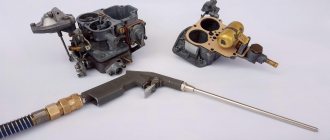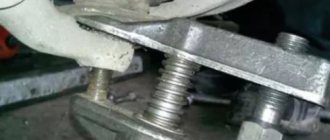Every car owner wants to save on fuel, especially in modern conditions. Of course, it is quite possible to realize such an idea if you install gas-cylinder equipment. Moreover, in specialized reputable services, where real professionals work, such work is completed in a matter of time.
Of course, before installing LPG, drivers should understand whether propane or methane is suitable as a fuel for your car’s engine, whether it can shorten the service life of the internal combustion engine as a whole, etc. As experienced experts say, problems can only be avoided when the owner of the vehicle means will be able to select the equipment correctly - then it will not cause any harm to the engine. Consequently, the owner will be able to save significantly.
Basic tools for setting up 4th generation HBO. Peculiarities
In addition to installing the unit, it is necessary to configure it, since setting up the 4th generation gas equipment plays an important role. If you want to know how to connect a 4th generation HBO with your own hands, how to adjust a 4th generation HBO yourself, you need to carefully study the intricacies of this issue.
To set up the equipment, you will need some parts:
- a program designed for this purpose;
- a special cable that will allow connection to the control unit of the unit;
- diagnostic cable.
Step-by-step calibration algorithm
Note! The fuel level sensor is calibrated on an empty gas cylinder. If there are fuel residues in the cylinder, calibration should not be started!
Calibration of the gas level sensor is carried out as follows:
- Apply voltage to the gas/petrol switch button. This can be done by turning on the car ignition and waiting for the button indication to light up. It is not necessary to start the car.
- Press the gas/petrol switch button and wait for the sound signal.
- Turn off the ignition for three seconds without releasing the button.
- After the button enters the programming mode (accompanied by an indication of an increase in the fuel level from the minimum value to the maximum and vice versa).
- Fill the gas cylinder full to the cut-off point.
- Turn on the ignition; you do not need to start the car.
- If calibration is successful, the indication of the increase in fuel level from the minimum to the maximum value and back should go through twice, after which it will display “full tank”. All green indicators should be lit.
If the sequential growth of the indicators on the button continues 5 times, then something went wrong and the calibration could not be completed.
If the setup process is not successful, you should understand the reasons, be sure to study the errors that are present in the electronic control unit and, after eliminating them, repeat the process of calibrating the gas sensor indicator.
Source
Settings options
In order for the adjustment of the 4th generation HBO to take place correctly and competently, you need to understand that you will need to choose two options, which, in fact, will allow you to do this.
- For example, it is always possible to correctly configure the LPG, having only a cable designed to adjust the unit, doing this by changing the injection time. When this option is used, older versions of programs are ideal.
- You can achieve success using a diagnostic scanner, this is done by fuel correction. Of course, if you have a diagnostic scanner or adapter at hand, you can always configure it with one program or another.
It is important to know. It should be understood that the load on the engine is not only an increase in speed, as many drivers believe. This statement is not at all true, since when accelerating in neutral gear, of course, the speed will soar to the limit, but at the same time the load is low.
Fuel level sensor calibration
Modern LPG systems monitor the presence of gas in the cylinder by lighting the LEDs on the gas/gasoline switch button, which is located in the vehicle interior. This convenient method allows the motorist to monitor the presence of gas in the cylinder without leaving the cab. But sometimes the gas level indicator displays completely incorrect values, in which case calibration of the fuel level sensor is required.
Rough adjustment for load. Peculiarities
When this option is selected, it is customary to change the cells; this is done not by revolutions, but solely by injection time. All that is required is to remember the fuel injection time, this is done at certain points in the movement, after which you need to switch to gas. This is how the 4th generation gas equipment is configured, the nozzles are adjusted and the work in general occurs. In addition, the 4th generation HBO, namely the pressure adjustment of the reducer, plays an equally important role.
It is important to know! As for the working pressure after the auto-calibration procedure, it will be automatically set, and at the level at which the adjustment is carried out. Regarding the minimum pressure, this is the gas pressure below which the system will automatically switch the vehicle to gasoline.
Attention: Every driver must understand that adjustment of the LPG gearbox, as a rule, is required only at the time of installation of the unit. But after one hundred thousand kilometers, it is necessary to perform diagnostics. It is also possible to service 4th generation gas equipment with your own hands, but only if you have the appropriate experience, knowledge, and equipment that allows you to do this.
If you consult with specialists, you can find out how to remove 4th generation HBO with your own hands, doing it at home. You always need to know that the proper operation of the unit does not depend on the quality of the electronic settings, as for some reason most car owners believe. Indeed, after a certain period of operation, valves and membranes begin to wear out, resulting in excessive gas consumption.
But this unpleasant moment can be delayed if you learn about the intricacies of proper operation of the equipment. For example, as for starting the engine, this should always happen exclusively on the car’s native fuel, which is often forgotten. Only at the moment when the engine temperature reaches thirty degrees can you switch to gas.
This is explained by the fact that the gearbox membrane freezes in practice at low temperatures. Therefore, the gearbox must be connected to the antifreeze lines, and only this way. If you want to configure the 4th generation LPG gearbox yourself, you need to realize in advance that this is not as easy to do as it seems.
Before doing such work, do not forget to warm up the engine, after which you can turn off the gasoline supply. If there is a need to adjust the sensitivity of the gearbox, then you need to unscrew the sensitivity regulator, and the procedure is performed at the moment until the idle speed values change.
You might be interested in >> Maintenance of gas equipment
Next you need to tighten the regulator and check the setting. All you need to do is press the accelerator pedal - the engine should not react to such an action, and accordingly, you should notice the absence of delays and jerks. Of course, if you managed to configure the 4th generation LPG yourself, and you did everything correctly, then the internal combustion engine will work stably and accurately.
Types of gas equipment systems for cars
Gas cylinder equipment is divided into two types, depending on the type of gas used. The most common propane gas treatment systems in our country use a mixture of propane and butane. The advantage of these systems is based on relatively inexpensive equipment and a wide network of gas stations covering the entire territory of our country.
Gas filling stations may not look as bright and beautiful as gasoline ones, but finding a gas station will not be a problem in any region of our country. An additional convenience of propane gas equipment for a car is gas cylinders, which come in two types: cylindrical and toroidal, which can be placed in the spare wheel niche.
The second type of gas equipment on cars is methane gas systems. Methane is exactly the gas that our Gazprom corporation actively trades around the world. Methane equipment is more expensive, but the use of methane is more profitable, because it's cheaper than propane. The disadvantages of methane are: firstly, heavy and expensive methane cylinders, and secondly, an undeveloped network of methane filling stations.
According to their principle of operation, HBO systems are divided into traditional and injection.
Traditional LPG is intended mainly for carburetor cars and uses the principle of carburetion. The air entering the engine passes through a special mixer and sucks in the required amount of gas - the harder the driver presses the gas pedal, the more the throttle valve opens, the more air enters the engine, the more gas is sucked into the engine along with this air.
Gas injection equipment on a car is similar to a gasoline injection system, that is, gas enters the engine through gas injectors controlled by LPG electronics. The basic operating principle of gas injection equipment is to be invisible to the car’s standard electronics, i.e. The car control unit does not suspect that an alternative fuel is being used instead of gasoline.
The word “gas” itself carries a certain danger, so manufacturers of gas systems pay great attention to the safety of their systems.
The gas cylinder fittings are equipped with fire, emergency and solenoid valves, as well as a valve that shuts off the gas flow in the event of a gas line break. Under the hood of the car, gas-cylinder electronics instantly shut off the gas supply if gasoline is used or the car’s engine is stopped. For a detailed description of the operating principle and safety of HBO, see here.
All components of gas equipment undergo mandatory certification and numerous tests confirming their safety. Safety standards for gas equipment on cars installed on the secondary market are absolutely identical to the standards for gas cars produced by automakers. By installing gas equipment on your car, you can be sure that you are protected in the same way as the owner of a gas car with gas equipment installed directly on the conveyor.
There are some opinions about the dangers of using gas equipment in a car. In fact, this is nothing more than a myth. See refutations of the most common myths about HBO.
Gas equipment can be divided into several classes.
The first class includes the so-called branded systems. This is an LPG supplied and consisting entirely of components from one manufacturer. Of course, this equipment is the best and most balanced. Each component of such a system knows how its neighbor works, and using this information allows you to achieve the best performance: maximum savings and minimal power loss.
The second class is HBO systems of the so-called “salad” type. This is when components from different manufacturers, assembled into one kit, are sold under a name, usually created by the seller of that arrangement. These “salad” systems can also be divided into two subclasses:
- systems assembled from components from Italian manufacturers are quite high-class;
- systems mainly consisting of Turkish or Chinese components.
Of course, the latter is a lower class option.
And finally, the fourth class includes the relatively recently appeared counterfeits of branded gas equipment for cars, made in China. It makes no sense to talk about any quality of this HBO at all.
Currently, in addition to traditional and injection gas-cylinder equipment on cars, new directions of development have appeared. These are diesel gas systems, so-called gas diesel engines. In other words, the use of gas in diesel cars.
In such LPG systems, gas is supplied to the engine simultaneously with the supply of the main fuel - diesel. The use of gas-diesel equipment can significantly reduce fuel costs, this is especially true for use on long-haul tractors.
The second modern direction is the use of gas in gasoline cars with direct gasoline injection. On these modern cars, gasoline injectors are installed directly into the combustion chamber of the engine. LPG for direct injection, which can be installed on these machines, also uses the simultaneous supply of gas and gasoline.
Another modern trend is the deepening of connections between gas and automotive control systems. Modern gas equipment can communicate with standard car controllers through data transmission systems using certain protocols, which allows you to inform the driver, for example, through an on-board computer about problems or malfunctions in the operation of gas equipment.
Features of operating equipment manufactured by Lovato
It should be remembered that Lovato gas equipment should be serviced exclusively in specialized service centers that are equipped with everything necessary. At the same time, there are HBOs for both carburetor and injection cars, so the equipment can be freely installed on all types of vehicles. Gas coming from a cylinder under a pressure of about 16 atm undergoes special cleaning through a filter, after which it enters the gearbox, where it is reduced to 1 atm, after which the finished mixture is supplied to gas injectors for injection into the engine cylinders.
Method for adjusting gearboxes with two adjusting screws
The gearbox regulates two main parameters: the pressure in the second stage (hereinafter referred to as “sensitivity” - this is closer to the truth) and the amount of gas passing through the idle channel - the idle screw.
The engine must be started on gasoline and warmed up to operating temperature.
Initial adjustment position:
- the dispenser is turned to the maximum (maximum cross-section of the gas supply channel);
- screw the idle speed screw all the way and then unscrew it 3–5 turns;
- The sensitivity screw is set to the middle position.
Idle speed setting
Start the car on gas. If this fails, then start it on gasoline and switch to gas, maintaining the speed at about 2000 rpm. Reduce the speed to idle and turn the idle speed screw to find its position when the engine does not stall. If the engine stalls, repeat the operation until the idle speed is stable (idling speed). Then, turning the idle speed screw, you need to find the maximum speed. Next, gradually tighten the sensitivity screw; if the speed changes, then you need to adjust it with the idle speed screw to maximum. If that doesn’t work, turn the sensitivity screw 2 turns and repeat again. As a result, the sensitivity screw is turned almost all the way, the engine idles at maximum - somewhere around 1100–1200 rpm. Using the idle screw, turn it in to lower the speed slightly below the nominal speed and then turn it back, set it to 950–1000 rpm.
How much will HBO cost?
The cost of gas equipment for a car depends on the kit. It includes:
- electronic control unit;
- gearbox;
- balloon;
- filling device;
- multivalve;
- filter;
- nozzles;
- highways;
- switch button.
For each engine, a kit is selected either from one manufacturer or prefabricated. For example: the ECU is from Stag, and the gearbox, cylinder and injector are from Lovato.
The price of HBO is affected not only by its layout, but also by the type of cylinder. It can be cylindrical - installed in the trunk, or toroidal - for installation in a niche instead of a spare wheel. The latter is more expensive.
The more powerful and complex the engine, the more expensive the gas equipment will cost. The price of equipment is from 11 thousand rubles.
Basic safety requirements
Any Lovato brand gas equipment, regardless of modification and features, requires an exclusively qualified approach, and therefore the work of installing and adjusting the equipment should be entrusted to professionals. Illiterate actions or an incompetent approach can lead to failure of expensive equipment, as well as serious damage. Our specialists are highly qualified and have extensive experience in installing Lovato gas equipment. The company’s convenient location in Moscow and favorable prices will be appreciated by drivers who want to install gas equipment without spending a lot of time and money!
How to choose the right equipment for your car?
A car owner who has not previously encountered gas equipment will find it difficult to decide on its choice. To avoid problems with the engine in the future, you should entrust the selection, installation and configuration of LPG to trusted specialists. Based on the characteristics of the internal combustion engine, they will select the necessary equipment and advise on operation issues.
It is worth considering that the gasoline engine is not designed to work with gas. Therefore, car manufacturers, when installing factory gas equipment, also make changes to the internal combustion engine, adapting it to work on gas.
How to calibrate the fuel level sensor
To constantly monitor the gas level in the cylinder, an LED indication is used, which is located on the button used to switch from gasoline to gas. Sometimes malfunctions occur that distort the readings. In this case, calibration of the gas level sensor is required.
Incorrect sensor readings can be indicated by various readings on the button and directly on the gas cylinder. You can calibrate the indicator yourself. For these purposes, first of all you need to connect the ECU to the laptop and set the correct value. To correctly perform this operation, you need to know exactly the model of the sensor that is installed on your car, as well as know its operation scheme (voltage measurement or resistance measurement). After setting all the necessary values, proceed directly to calibration.
How can you distinguish original Lovato equipment from counterfeits?
When purchasing gas equipment under the Lovato brand, you should be especially careful, since, unfortunately, there are fakes on the market. Of course, the manufacturer does not bear any responsibility for counterfeit goods, which, as a rule, are made from low-quality components and are sold at a deliberately lower price. That is why, in order to avoid the risk of installing a counterfeit on your car, it is important to take into account the following features of the original LPG:
- The Lovato symbol must be stamped on the solenoids, coils and gearbox.
- The gear housing must contain a logo and part number
- Each gas cylinder installation unit has a corresponding document
- The numbers on the gearbox and on the passport must match

